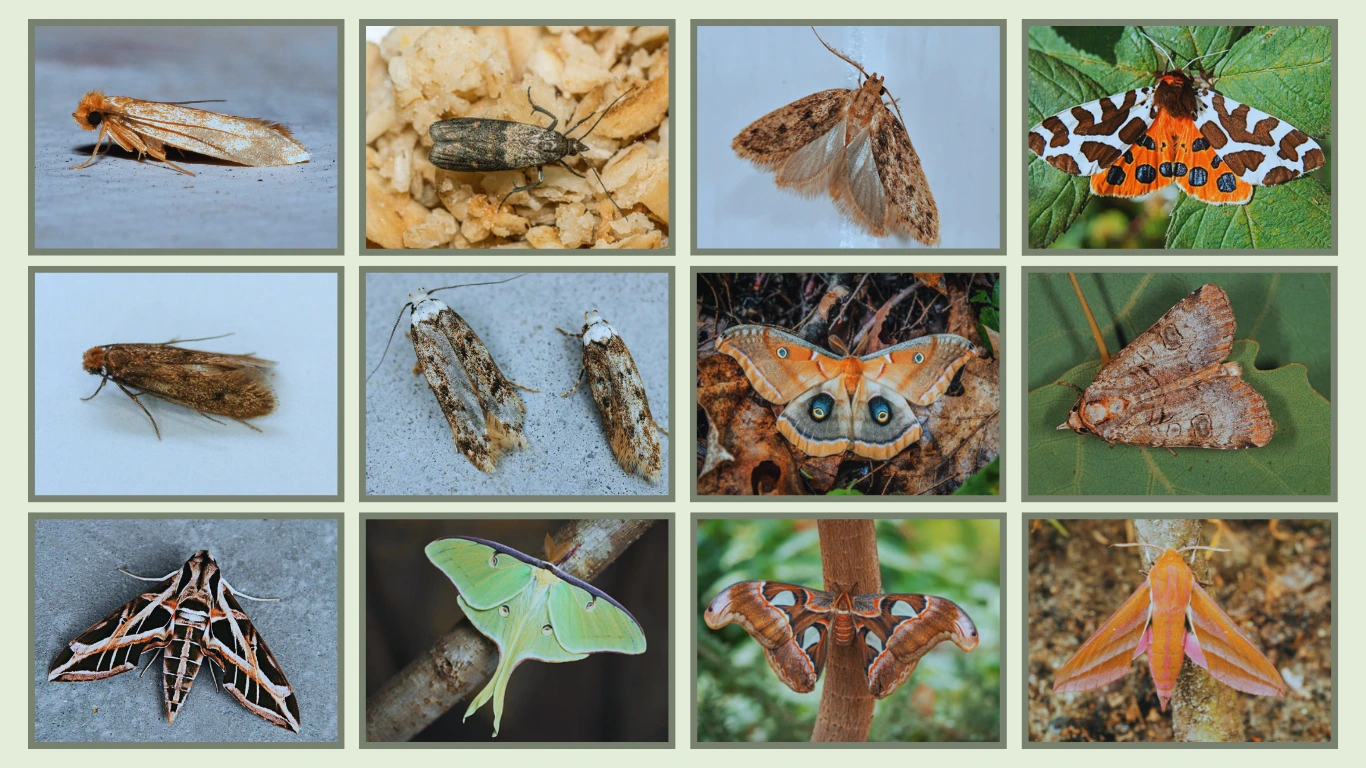Moths are more than just night-flying insects—they’re diverse, colorful, and sometimes even helpful. From tiny clothes moths hiding in your wardrobe to the massive and majestic atlas moth, these creatures vary wildly in size, color, and lifestyle. Some are pests, others are pollinators, and a few are just plain beautiful.
In this guide, you’ll discover 30 unique types of moths from around the world. Each section includes identification tips, behavior, habitat, and what they eat—perfect for nature lovers, gardeners, or anyone curious about what’s fluttering around the lights at night.
1. Clothes Moth (Tineola bisselliella)

The clothes moth is one of the most recognized moths due to its reputation for damaging fabrics. Unlike most moth species that feed on nectar or live outdoors, this moth has adapted to human environments, especially where natural fibers are stored. Though small and inconspicuous, its larvae can cause significant damage, earning it a place on nearly every pest control list.
Identification
- Size: 6–8 mm in length
- Color: Light golden or buff-colored body and wings
- Wings: Narrow with long fringes, held roof-like over the body
- Markings: No visible spots or patterns
- Larvae: White, worm-like, with dark heads
Habitat
Clothes moths are found almost exclusively in indoor environments. They seek dark, quiet areas like closets, storage bins, and under furniture—especially where wool, fur, silk, or feathers are present. Outdoors, they are rarely seen as they rely on human-made environments for survival.
Lifecycle
A female clothes moth can lay 40–50 eggs directly on fabric. Larvae emerge within a week and feed for 1–3 months, depending on temperature and humidity. Pupation takes place in silk cocoons, and adult moths emerge shortly after. The entire lifecycle may complete in under 2 months in warm indoor conditions.
Behavior
Adult clothes moths avoid light and are rarely seen flying around. They prefer crawling and hiding in shadows, which often delays detection. Their quiet, secretive behavior is what makes infestations so hard to spot early.
Diet
Only the larvae feed—and their diet is quite specific. They require keratin, a protein found in animal-based fibers such as wool, silk, fur, feathers, and leather. Unlike many moths that feed on plants, nectar, or fruit, the clothes moth survives solely on household textiles and organic debris like pet hair.
2. Case-Bearing Clothes Moth (Tinea pellionella)
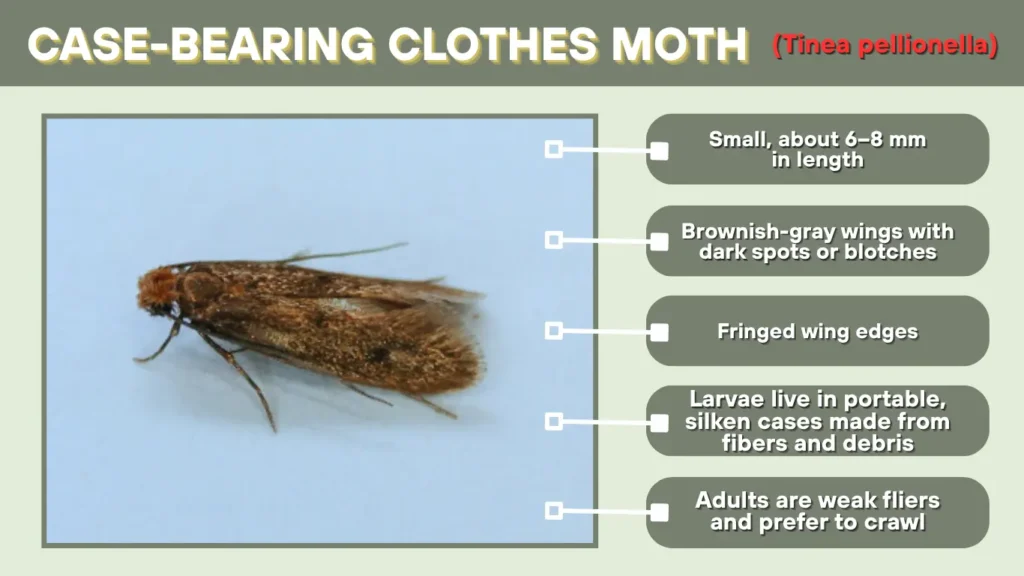
Closely related to the common clothes moth, the case-bearing clothes moth is equally destructive but slightly less known. Its larvae create and live in portable, silk cases made of fibers and debris, which they carry around while feeding. This behavior makes them easy to distinguish once spotted indoors.
Identification
- Size: 6–8 mm
- Color: Brownish wings with irregular dark spots
- Wings: Narrow with fringed edges
- Larvae: Cream-colored, inside cigar-shaped, mobile silk cases
- Case: Covered in fibers, bits of hair, or fabric
Habitat
Found mostly indoors in undisturbed areas like closets, behind baseboards, and under furniture. They seek fabrics made from natural animal fibers and often infest stored garments, upholstered furniture, or carpets.
Lifecycle
Females lay eggs directly on suitable fabrics. The larvae hatch and immediately begin building their silk cases. They feed for several weeks to months before pupating inside the same case. Adults live briefly and focus solely on reproduction.
Behavior
They are shy, avoid light, and are more often found crawling than flying. The larval cases can sometimes be seen moving slowly on vertical surfaces, like walls or baseboards.
Diet
Larvae feed on wool, silk, feathers, fur, and sometimes leather. Synthetic materials are not digested unless blended with natural fibers. Damage often shows as irregular holes or grazed patches on textiles.
3. Pantry Moth (Plodia interpunctella)

Also called the Indianmeal moth, this species is one of the most common pests found in stored food products. Unlike fabric moths, pantry moths are drawn to dry food items and often enter homes through infested packages from stores.
Identification
- Size: 8–10 mm
- Wings: Bicolored—gray on the inner half, coppery-brown on the outer half
- Larvae: Cream-colored, up to 12 mm, often found in food or packaging
- Appearance: Slender, with a clear band separating two wing colors
Habitat
Typically found in kitchens, pantries, and storage cabinets. They hide in food containers, packaging folds, and cracks near dry food. They are not fabric pests but contaminate food with webbing and droppings.
Lifecycle
Females lay hundreds of eggs on or near food. Larvae hatch quickly and feed for about 2–3 weeks. They leave food to pupate in nearby corners or crevices. The adult moth emerges in 1–2 weeks, completing the cycle in 1–2 months.
Behavior
Adults are active at night and often seen flying near lights or ceilings. Larvae are more destructive, tunneling into grains, flour, and other packaged goods.
Diet
Larvae feed on cereal, rice, grains, flour, dried fruit, nuts, powdered milk, and pet food. Infested food usually contains silk threads, clumps, and waste, rendering it inedible.
4. Brown House Moth (Hofmannophila pseudospretella)

Native to Asia but now common worldwide, the brown house moth is a general scavenger. Unlike other moths with a narrow diet, this species thrives in a variety of indoor conditions and feeds on both food waste and organic fabrics.
Identification
- Size: 8–14 mm
- Color: Shiny bronze or brown wings with darker spots
- Wings: Long, narrow, and often held flat
- Larvae: Cream-colored, with reddish-brown heads
Habitat
Found in pantries, basements, and damp storage areas. They prefer humid, poorly ventilated locations and are frequently found in older homes or where sanitation is poor.
Lifecycle
A female lays up to 600 eggs on available food or organic matter. Larvae feed for several weeks, then pupate in cracks, cupboards, or debris. Adults may live for 2–4 weeks. Indoors, multiple generations can occur yearly.
Behavior
Adults are active year-round and often seen resting on walls. They fly in short bursts and are more tolerant of light than clothes moths. Infestations often go unnoticed until damaged food or fabric is discovered.
Diet
Brown house moth larvae eat cereal, flour, dried fruit, animal hair, wool, leather, and even dead insects. This wide diet makes them especially adaptable to indoor living.
5. White-Shouldered House Moth (Endrosis sarcitrella)
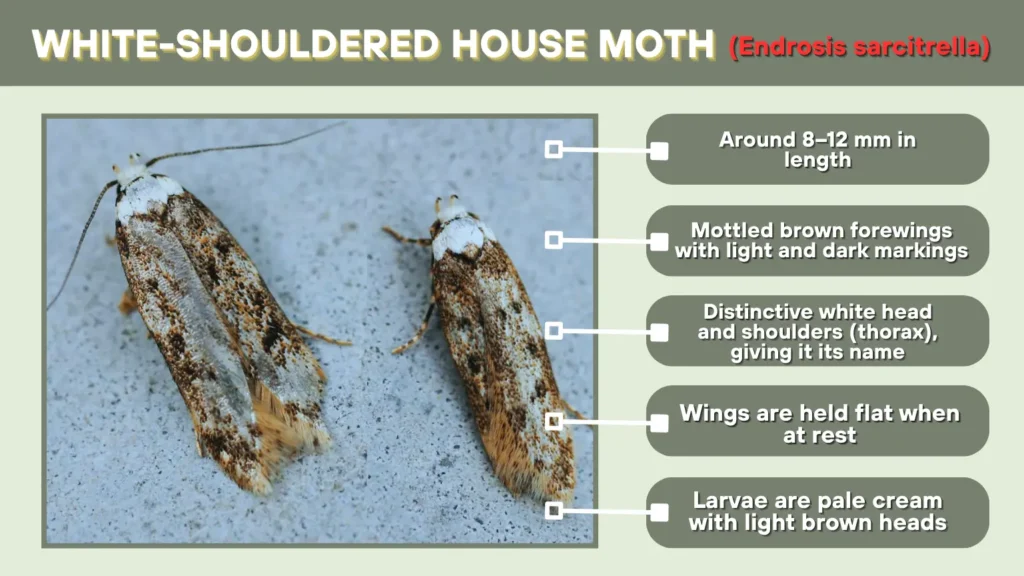
The white-shouldered house moth is a small, adaptable species found in homes, storerooms, and even industrial settings. Though not as destructive as clothes or pantry moths, it’s a common indoor presence and an indicator of poor storage or moisture issues.
Identification
- Size: 8–12 mm
- Color: Mottled brown wings with pale patches
- Distinct Feature: Bright white head and thorax (“shoulders”)
- Wings: Held flat over the body; fringed edges
- Larvae: White with light brown heads
Habitat
Prefers warm, humid indoor environments like kitchens, pantries, storage rooms, and occasionally attics. May also be found near bird nests or in animal feed storage areas. Attracted to light and organic debris.
Lifecycle
Females lay eggs near decaying or organic matter. Larvae feed and develop over several weeks, pupate in concealed spots, and emerge as adult moths. Indoors, the lifecycle may repeat continuously throughout the year.
Behavior
More tolerant of light than clothes moths, adults are often seen flying erratically near windows or light sources. They are active year-round in warm homes and less secretive than fabric moths.
Diet
Larvae feed on a wide variety of materials: dried food waste, grains, pet food, dead insects, feathers, and organic dust. They may also chew through packaging or paper, making them a nuisance in pantries and storerooms.
6. Miller Moth (Euxoa auxiliaris)

The miller moth is the adult form of the army cutworm and is best known for invading homes in huge numbers during its seasonal migration. It doesn’t feed on household items but can still cause inconvenience due to its erratic flying and large population spikes.
Identification
- Size: 30–40 mm wingspan
- Color: Grayish-brown with wave-like patterns and dusty scales
- Wings: Broad, mottled, and loosely covered with fine powder
- Behavior: Attracted to light, active at night
- Larvae: Army cutworms—agricultural pests
Habitat
Millers are outdoor moths that seek cool, dark shelter in homes, garages, sheds, and under eaves during migration. They don’t breed indoors but often get trapped inside through open windows or gaps.
Lifecycle
They overwinter as larvae (cutworms), pupate in spring, and emerge as moths. Adults migrate to higher altitudes for summer. They return in fall to lay eggs in fields and open ground.
Behavior
Miller moths are seasonal, appearing in spring and early summer. Indoors, they flutter around lights, windows, and ceilings. Though harmless, their large numbers and habit of hiding in cracks can be overwhelming.
Diet
Adults feed on nectar outdoors. They do not eat fabric or food and cause no physical damage inside the home—making them more of a nuisance than a pest.
7. Plaster Bagworm (Phereoeca uterella)

Often mistaken for a pest unique to tropical climates, the plaster bagworm is a relative of the clothes moth and is well-adapted to humid, dusty homes. It’s known for the unique, oval-shaped larval case that clings to walls, ceilings, and corners.
Identification
- Size: Adult wingspan 10–13 mm
- Color: Grayish or mottled light brown
- Larvae: Enclosed in a flattened, mobile case made of silk and lint
- Case: Oval, gray, and resembles a seed or scale
- Adults: Small and slender with narrow wings
Habitat
Most common in humid climates or poorly ventilated homes. Found in garages, laundry rooms, closets, and near baseboards or ceiling edges. They thrive in homes with dust, hair, and spider webs.
Lifecycle
Females lay eggs near dust or cobwebs. Larvae immediately spin their protective cases and remain inside as they grow. After several weeks or months, they pupate within the same case and emerge as adults. Multiple generations can develop indoors annually.
Behavior
Active year-round in warm, humid homes. The larvae are slow-moving and cling to walls or ceilings. The presence of many cases often signals an infestation. Adults are rarely seen.
Diet
Larvae feed on spider webs, pet hair, fabric lint, and organic debris. While not as aggressive as clothes moths, they can still damage wool and other natural fibers if conditions allow.
8. Luna Moth (Actias luna)
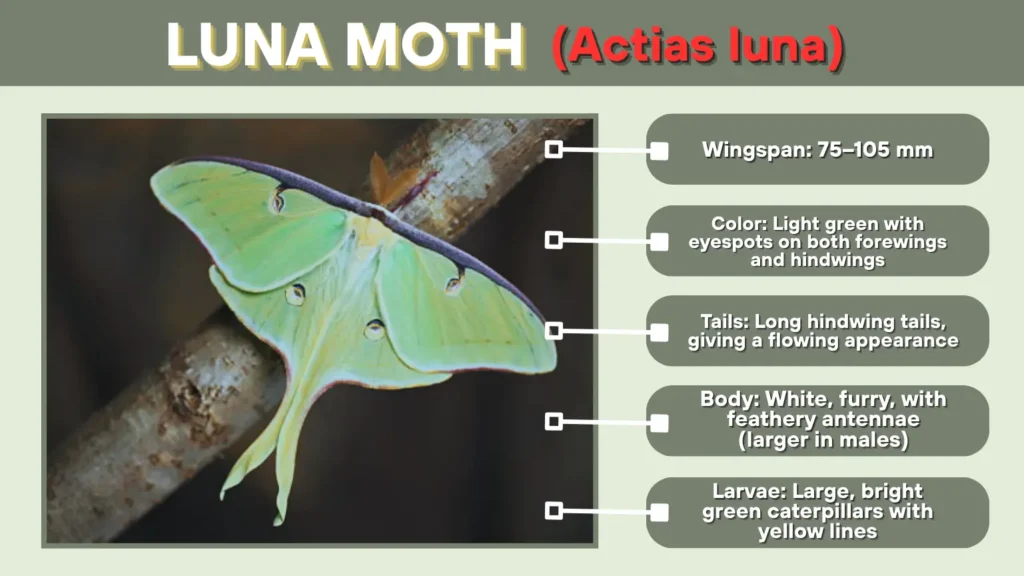
The luna moth is one of the most stunning moth species in North America, known for its large size and pale green wings with long trailing tails. Unlike pest moths, the luna moth is harmless and admired for its beauty and brief adult lifespan.
Identification
- Wingspan: 75–105 mm
- Color: Light green with eyespots on both forewings and hindwings
- Tails: Long hindwing tails, giving a flowing appearance
- Body: White, furry, with feathery antennae (larger in males)
- Larvae: Large, bright green caterpillars with yellow lines
Habitat
Luna moths live in deciduous forests and wooded areas throughout eastern North America. Adults are sometimes drawn to lights and can be seen on house siding or windows near forest edges.
Lifecycle
The female lays eggs on host tree leaves (like hickory, walnut, sweet gum). Larvae feed and molt through several stages before spinning a cocoon in leaves. Adults emerge in spring or summer, living only about 7–10 days to mate and lay eggs.
Behavior
Luna moths are nocturnal and strongly attracted to lights. They are graceful flyers but do not feed as adults. Their purpose is purely reproductive.
Diet
Adult luna moths do not eat. The caterpillars feed on the leaves of hardwood trees such as birch, walnut, persimmon, and hickory during their growth stages.
9. Atlas Moth (Attacus atlas)
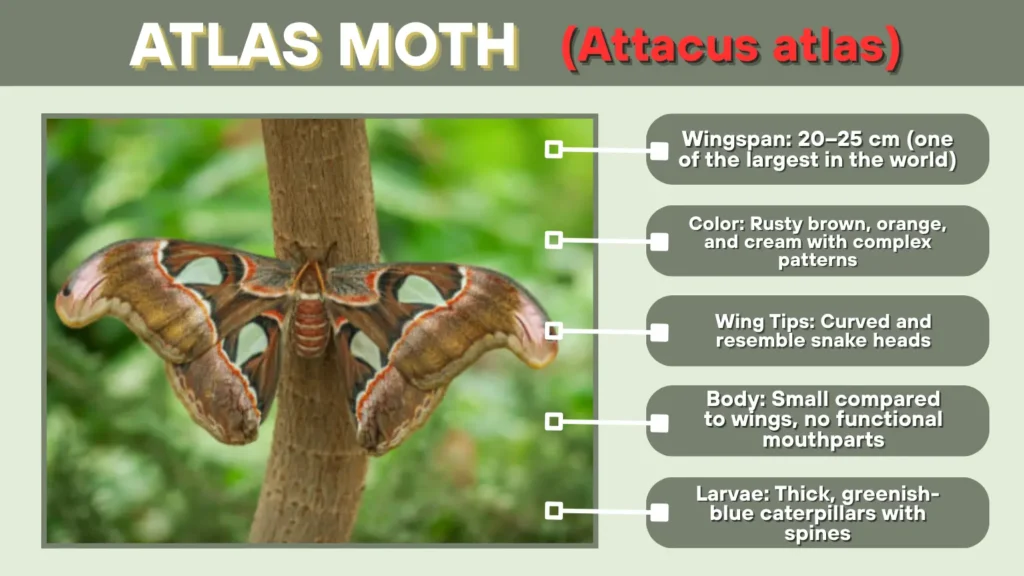
The atlas moth is among the largest moths in the world, with a wingspan that can reach up to 25 cm. Native to Southeast Asia, this moth is often kept in butterfly houses and is notable for wing tips that resemble a snake’s head—possibly to deter predators.
Identification
- Wingspan: 20–25 cm (one of the largest in the world)
- Color: Rusty brown, orange, and cream with complex patterns
- Wing Tips: Curved and resemble snake heads
- Body: Small compared to wings, no functional mouthparts
- Larvae: Thick, greenish-blue caterpillars with spines
Habitat
Found in tropical and subtropical forests of Southeast Asia, including India, Malaysia, and Indonesia. Rarely enters homes, but admired in aviaries and butterfly exhibits.
Lifecycle
Eggs are laid on host plants like citrus or guava. Caterpillars grow quickly, spin a papery silk cocoon, and emerge as giant adults. Adults live just 5–7 days without feeding.
Behavior
Nocturnal and generally quiet, adult atlas moths stay in place during the day. Their large size makes them appear intimidating, though they are harmless.
Diet
Adults do not feed and rely entirely on fat reserves from the caterpillar stage. Larvae feed on leaves of citrus, cinnamon, and evergreen trees.
10. Death’s-head Hawkmoth (Acherontia atropos)

Known for the skull-shaped marking on its thorax and eerie sound, the death’s-head hawkmoth is steeped in folklore and fear—but it’s completely harmless. It gained fame through movies and books and is one of the most distinctive moths in the world.
Identification
- Size: Wingspan 90–130 mm
- Color: Dark brown with yellow stripes on the abdomen
- Thorax: Distinct skull-like marking
- Larvae: Large, green or yellow with horned tails
- Unique Feature: Emits a loud squeak when disturbed
Habitat
Native to parts of Europe, Africa, and the Middle East. Typically found in gardens, open fields, and farmland. Rarely found inside homes but occasionally drawn to lights.
Lifecycle
Eggs are laid on host plants like potatoes or nightshades. Larvae grow large and burrow underground to pupate. Adults emerge and live for several weeks, often migrating in certain regions.
Behavior
Mostly nocturnal, adults are strong fliers and can even invade beehives to steal honey, thanks to a special enzyme that masks their scent. They are sometimes spotted near porch lights or windows.
Diet
Larvae feed on potato, tomato, and tobacco plants. Adults can feed on honey and nectar, though they do so sparingly and are more secretive than other hawkmoths.
11. Polyphemus Moth (Antheraea polyphemus)

The polyphemus moth is a large silk moth known for the prominent eyespots on its hindwings, which resemble owl eyes and help scare off predators. It’s widespread in North America and admired for its size and striking wing patterns.
Identification
- Wingspan: 10–15 cm
- Color: Tan to reddish-brown with yellowish lines and eyespots
- Eyespots: Large blue-and-black “false eyes” on hindwings
- Body: Thick and furry with a slightly banded abdomen
- Larvae: Large green caterpillars with silver spots
Habitat
Found in woodlands, suburban yards, and parks. Though not a house moth, it may visit well-lit areas at night. Common near oak, birch, and maple trees, which serve as larval food sources.
Lifecycle
Females lay eggs on a wide range of deciduous trees. The caterpillars feed heavily, grow up to 3 inches long, and spin large silk cocoons on branches or leaves. Adults do not feed and live for only about a week.
Behavior
Adults are mostly nocturnal and are drawn to lights. Despite their size, they are gentle and silent. During the day, they remain still with wings flat or slightly raised.
Diet
Larvae feed on oak, birch, willow, maple, and hickory leaves. Adults do not eat at all; their sole purpose is reproduction.
12. Cecropia Moth (Hyalophora cecropia)

The cecropia moth is the largest native moth in North America and belongs to the giant silk moth family. It is spectacular in appearance and completely harmless, often found in late spring or early summer.
Identification
- Wingspan: 13–16 cm
- Color: Brownish-red wings with white crescent-shaped marks
- Margins: Cream, red, and black edging
- Body: Thick, striped red and white
- Larvae: Bright green with blue and yellow tubercles
Habitat
Common in deciduous forests, suburban areas, and gardens with host trees like maple, cherry, and apple. Rarely found indoors but may appear near outdoor lights.
Lifecycle
Females lay small groups of eggs on leaves. Caterpillars go through five stages before spinning tough silk cocoons. Adults emerge in late spring. With no mouths, adults live for only about one week.
Behavior
They are nocturnal and easy to observe near lights. During the day, they rest on tree trunks or leaves. Males have large, feathery antennae to detect females from long distances.
Diet
Caterpillars feed on a variety of trees: cherry, birch, maple, apple, and dogwood. Adult moths do not feed.
13. Rosy Maple Moth (Dryocampa rubicunda)

The rosy maple moth is one of the most colorful moths in North America. Despite its bright pink and yellow colors, it is not poisonous or dangerous. It’s most often seen in late spring and early summer near maple trees.
Identification
- Size: Wingspan 3.2–5.0 cm
- Color: Pink and yellow wings with a fuzzy pink body
- Unique Look: Bubblegum-colored appearance, often mistaken for butterflies
- Larvae: Known as greenstriped mapleworms—green with yellow and black stripes
Habitat
Found near maple trees in wooded suburbs, parks, and forest edges. They are common in the eastern U.S. and are attracted to light, which can bring them to porches and windows.
Lifecycle
Eggs are laid on the underside of maple leaves. Larvae feed in groups when young and pupate in soil or leaf litter. Adults emerge and mate in early summer.
Behavior
They are mostly active at dusk and night. During the day, they hide among foliage. Their bright colors provide a surprising level of camouflage among flowers and foliage.
Diet
Larvae feed almost exclusively on maple leaves, especially red and silver maple. Adults do not feed.
14. Elephant Hawk Moth (Deilephila elpenor)

The elephant hawk moth is a striking species known for its vibrant pink and olive-green coloring. Found throughout Europe and parts of Asia, it’s a favorite among gardeners for its beauty and the hummingbird-like flight of its caterpillars and adults.
Identification
- Wingspan: 45–60 mm
- Color: Bright pink and olive-green wings
- Body: Pink-striped with a streamlined shape
- Larvae: Large, gray-brown caterpillars with eye-like spots and a trunk-like front
Habitat
Found in gardens, woodland edges, and hedgerows—often near honeysuckle or fuchsia. Not typically an indoor moth, but may appear near windows at night due to light attraction.
Lifecycle
Females lay eggs on host plants like willowherb or fuchsia. Larvae feed for several weeks, then burrow into soil to pupate. Adults emerge in late spring to summer.
Behavior
Active at dusk and night, they are fast fliers and often mistaken for hummingbirds. Caterpillars have a defensive trick—rearing up and exposing false eyes to scare predators.
Diet
Caterpillars feed on rosebay willowherb, fuchsia, bedstraw, and related plants. Adults feed on nectar and are beneficial pollinators.
15. Hummingbird Moth (Hemaris spp.)
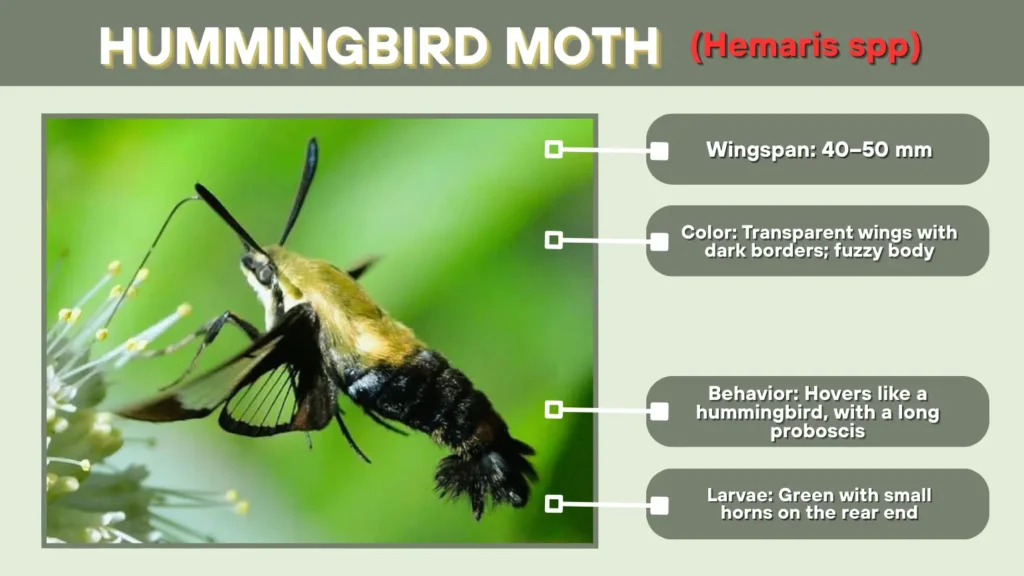
Hummingbird moths are day-flying moths that resemble hummingbirds due to their fast wingbeats and hovering flight. They belong to the sphinx moth family and are excellent pollinators.
Identification
- Wingspan: 40–50 mm
- Color: Transparent wings with dark borders; fuzzy body
- Behavior: Hovers like a hummingbird, with a long proboscis
- Larvae: Green with small horns on the rear end
Habitat
Found in gardens, meadows, and woodland edges across North America, Europe, and Asia. Frequently seen visiting flowers in full daylight.
Lifecycle
Eggs are laid on host plants like honeysuckle and viburnum. Caterpillars grow rapidly and pupate in leaf litter. Adults emerge in late spring and are active throughout summer.
Behavior
Unusual among moths for being active during the day. Often mistaken for bees or hummingbirds due to their hovering and feeding style. Very fast and agile in flight.
Diet
Adults feed on nectar from flowers like phlox, bee balm, and milkweed. Larvae feed on various plants depending on the species.
16. Io Moth (Automeris io)

The Io moth is a large, colorful North American species best known for the vivid eyespots on its hindwings, which serve as a defense mechanism. It is beautiful to see but its caterpillars can sting.
Identification
- Wingspan: 50–80 mm
- Color: Males are yellow; females are brown
- Hindwings: Large, black-and-blue eyespots used to scare predators
- Larvae: Bright green with venomous spines
Habitat
Found in forests, fields, and gardens throughout eastern and southern North America. Adults may be attracted to lights but are rarely indoor pests.
Lifecycle
Eggs are laid in clusters on host plants. The larvae feed in groups when young and eventually spread out. Pupation occurs in leaf litter or soil, with adults emerging in spring or summer.
Behavior
Nocturnal and short-lived as adults. When disturbed, the moth flashes its hindwings to display the eyespots as a defense. Larvae should not be handled due to their stinging spines.
Diet
Larvae feed on many trees and shrubs including willow, elm, rose, corn, and hibiscus. Adults do not eat.
17. Tiger Moth (Arctia caja)

The tiger moth is a bold and colorful species found across Europe, Asia, and North America. Its vivid wing patterns and fuzzy body make it easy to recognize, and it plays a role in deterring predators through both appearance and chemical defenses.
Identification
- Wingspan: 45–65 mm
- Forewings: Dark brown with creamy white markings
- Hindwings: Bright orange with bold black spots
- Body: Furry with orange and black striping
- Larvae: Known as “woolly bears,” thick and bristly
Habitat
Tiger moths are found in gardens, grasslands, meadows, and woodland clearings. Though not household pests, adults are sometimes drawn to porch lights.
Lifecycle
Eggs are laid on a wide variety of low plants. Larvae overwinter and pupate in spring. Adults emerge in summer, mate, and lay eggs soon after.
Behavior
Nocturnal and strong fliers, but often rest during the day. Their vibrant colors warn predators of their unpalatability. The caterpillars curl up when touched.
Diet
Caterpillars feed on dandelions, nettles, plantains, and dock. Adults may sip nectar but are primarily focused on mating.
18. Gypsy Moth (Lymantria dispar)

The gypsy moth is a highly invasive species in North America, originally introduced from Europe. It has caused serious defoliation of forests and hardwood trees, especially during outbreak years. It’s considered a major ecological pest.
Identification
- Wingspan: Males 35–40 mm, females up to 65 mm
- Males: Brown and slender with feathery antennae
- Females: White with black markings, flightless in some regions
- Larvae: Hairy with blue and red spots on the back
Habitat
Found in forests, suburban areas, and even city parks. During outbreaks, larvae may be seen crawling on walls, sidewalks, and even buildings.
Lifecycle
Egg masses are laid on bark, rocks, or man-made structures and covered with fuzzy tan scales. Larvae hatch in spring and feed voraciously for several weeks. Pupation occurs in tree bark or hidden areas. Adults emerge mid-summer.
Behavior
Larvae are aggressive feeders and move in large groups. Adults are mostly inactive; males fly to find females. Females lay eggs and die shortly after.
Diet
Larvae feed on over 300 tree and shrub species, especially oaks, birch, and aspen. Adults do not feed.
19. Sphinx Moth (Sphingidae family)

Sphinx moths, also called hawk moths, are known for their fast, hovering flight and large size. They’re often confused with hummingbirds when feeding at flowers, and their caterpillars—hornworms—are common in gardens.
Identification
- Wingspan: Varies by species, typically 50–130 mm
- Color: Brown, gray, or green with streamlined bodies
- Larvae: Large, smooth with a horn-like projection at the rear
- Flight: Fast and agile, capable of hovering
Habitat
Found worldwide, especially in gardens, forests, and open fields. Frequently seen near flowers in the evening or at dusk.
Lifecycle
Eggs are laid on host plants such as tomato, tobacco, or evening primrose. Larvae feed heavily and pupate underground. Adults emerge to mate and feed.
Behavior
Active at dusk and night, they hover in front of flowers like hummingbirds. Some species can travel great distances and migrate seasonally.
Diet
Larvae feed on specific host plants depending on the species. Adults feed on nectar using a long proboscis, making them efficient nighttime pollinators.
20. Peppered Moth (Biston betularia)

The peppered moth is best known for its role in studies on natural selection and industrial evolution. It comes in two main color variations—light and dark—which helped scientists observe how environmental changes affect species survival.
Identification
- Wingspan: 45–62 mm
- Color: Typically white or pale gray with black speckles (peppered form)
- Melanic Form: Almost completely black or dark brown
- Larvae: Green or brown twig-like caterpillars
Habitat
Found across Europe, North America, and parts of Asia. Common in wooded areas, gardens, and parks, often resting on tree trunks during the day.
Lifecycle
Eggs are laid on tree leaves. Larvae mimic twigs for camouflage. They pupate in soil or leaf litter. Adults emerge in spring or early summer and are active for several weeks.
Behavior
Nocturnal and attracted to lights. Their wing coloration helps them blend into lichen-covered or soot-darkened tree bark, depending on the environment.
Diet
Caterpillars feed on leaves of birch, willow, oak, and other deciduous trees. Adults do not feed.
21. Winter Moth (Operophtera brumata)

The winter moth is a cold-weather species that emerges in late autumn and early winter—an unusual time for moth activity. It is considered a pest in both Europe and North America due to its tree-defoliating larvae.
Identification
- Wingspan: Males 20–30 mm; females are wingless
- Males: Pale brown or gray with narrow wings and faint banding
- Females: Small, gray, and wingless—crawl to tree trunks to lay eggs
- Larvae: Pale green inchworms
Habitat
Found in temperate climates, especially around deciduous forests, orchards, and suburban neighborhoods. Often seen near tree trunks in winter.
Lifecycle
Eggs are laid in late fall on bark or twigs. Larvae hatch in early spring and feed on leaf buds. After feeding, they pupate in soil and remain dormant until the next winter.
Behavior
Adults emerge and mate during winter evenings. Males fly, while females crawl up trees. Larvae can balloon through the air on silk threads to reach feeding sites.
Diet
Caterpillars feed on buds and leaves of oak, maple, apple, cherry, and other trees. Adults do not eat.
22. Leopard Moth (Zeuzera pyrina)
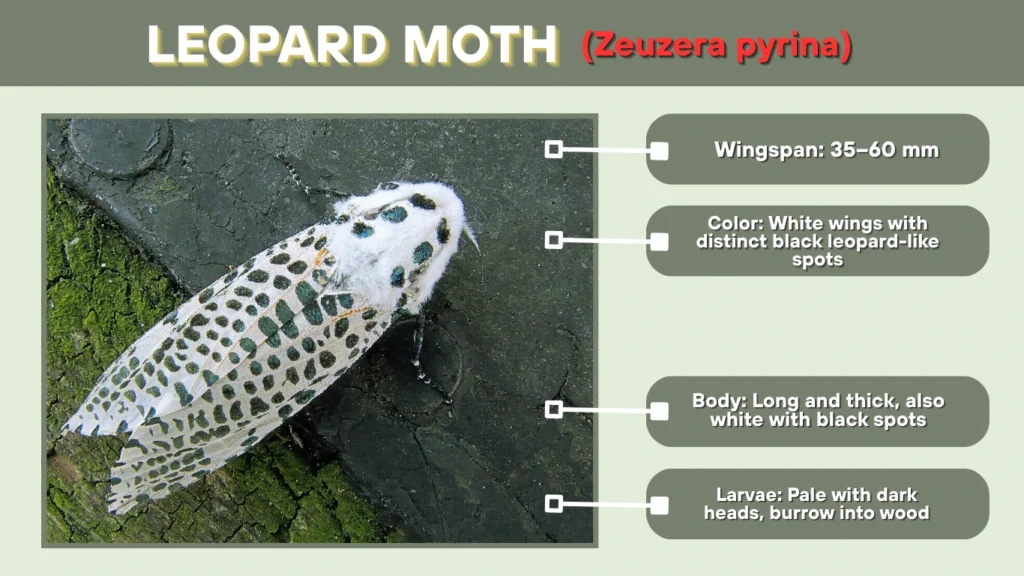
The leopard moth is a strikingly patterned species with bold black spots on its white wings. Despite its pretty appearance, the larvae are wood-borers that can cause damage to trees and ornamental shrubs.
Identification
- Wingspan: 35–60 mm
- Color: White wings with distinct black leopard-like spots
- Body: Long and thick, also white with black spots
- Larvae: Pale with dark heads, burrow into wood
Habitat
Found across Europe, the Middle East, and parts of North America. Inhabits orchards, urban gardens, and wooded areas—especially where fruit or hardwood trees are present.
Lifecycle
Eggs are laid on bark or in crevices. Larvae bore into trunks and branches, feeding on internal wood. They may remain inside the tree for up to two years before pupating and emerging as adults.
Behavior
Adults are nocturnal and often attracted to lights. Despite their size, they are weak fliers. Infestations often go unnoticed until internal tree damage is observed.
Diet
Larvae feed inside the wood of fruit trees (apple, pear, cherry), as well as walnut, maple, and elm. Adults do not feed.
23. Emperor Moth (Saturnia pavonia)

The emperor moth is a beautiful European silk moth that’s notable for its vivid eyespots and wide distribution. Unlike some giant silk moths, both males and females of this species can fly.
Identification
- Wingspan: Males 40–60 mm; females up to 80 mm
- Color: Grayish-brown with bold, colorful eyespots on all wings
- Males: More brightly colored and smaller
- Larvae: Bright green with black bands and yellow spots
Habitat
Found across heathlands, grasslands, and moorlands in Europe. They prefer areas with low vegetation such as heather and bramble. Rarely enters homes, but seen near lights in rural areas.
Lifecycle
Eggs are laid in rows on twigs or leaves. Larvae feed through summer, pupate in a silken cocoon, and overwinter. Adults emerge in early spring and live only a few days to reproduce.
Behavior
Day-active (diurnal), especially the males, who fly swiftly in search of females. Eyespots are used to deter predators when threatened.
Diet
Caterpillars feed on bramble, heather, hawthorn, and willow. Adults do not feed.
24. Comet Moth (Argema mittrei)
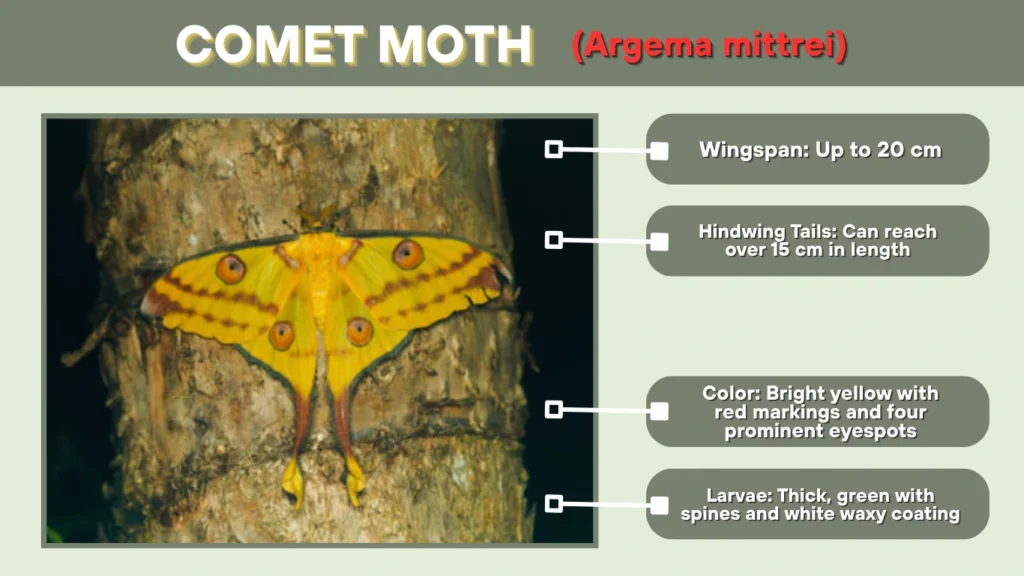
Also known as the Madagascan moon moth, the comet moth is one of the largest and most visually stunning moths in the world. It’s native to Madagascar’s rainforests and known for its extremely long hindwing tails.
Identification
- Wingspan: Up to 20 cm
- Hindwing Tails: Can reach over 15 cm in length
- Color: Bright yellow with red markings and four prominent eyespots
- Larvae: Thick, green with spines and white waxy coating
Habitat
Endemic to Madagascar, primarily in humid rainforest regions. It’s not found in homes naturally but is popular in butterfly houses and conservation exhibits.
Lifecycle
Females lay eggs on the leaves of host trees. Larvae feed and grow rapidly before spinning large cocoons. Adults emerge with no functioning mouthparts and live for only 4–5 days.
Behavior
Nocturnal and short-lived. Adults do not feed and rely entirely on fat reserves stored during the larval stage. They display their tails and eyespots to confuse predators.
Diet
Larvae feed on eucalyptus and other rainforest trees. Adults do not eat.
25. Garden Tiger Moth (Arctia caja)
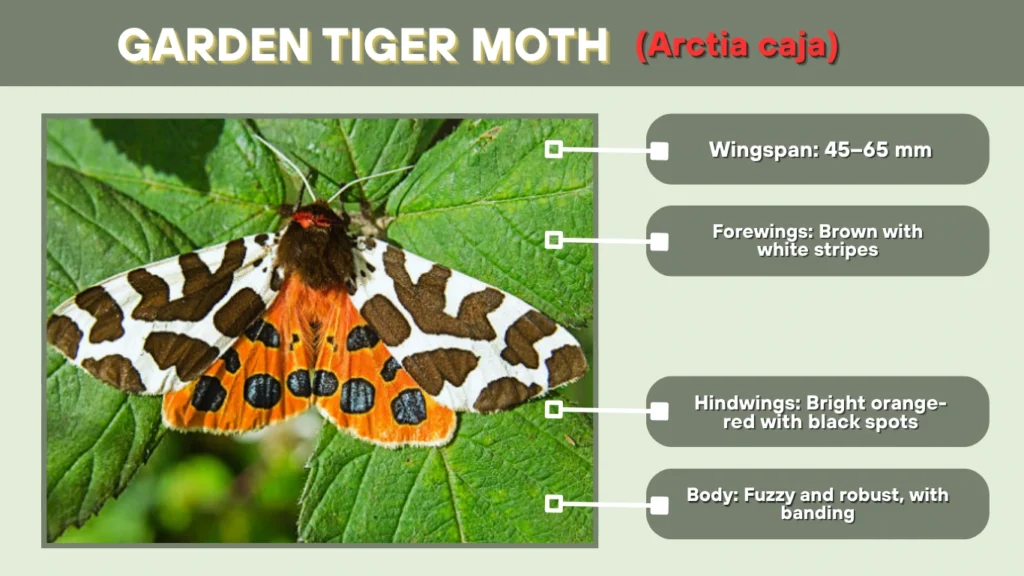
The garden tiger moth is a boldly patterned moth native to Europe and North America. It’s famous for its contrast of forewing camouflage and shocking hindwing display, which helps deter predators.
Identification
- Wingspan: 45–65 mm
- Forewings: Brown with white stripes
- Hindwings: Bright orange-red with black spots
- Body: Fuzzy and robust, with banding
- Larvae: Known as woolly bears—hairy and brownish-black with rust-colored bands
Habitat
Common in gardens, fields, wetlands, and forest edges. They prefer cooler, temperate climates and are often seen in urban gardens during summer.
Lifecycle
Eggs are laid on low-growing plants. The larvae hibernate through winter and pupate in spring. Adults emerge in summer, usually in a single generation per year.
Behavior
Mostly nocturnal but may be seen resting on leaves or walls during the day. When threatened, they reveal their red hindwings to startle predators.
Diet
Caterpillars feed on dandelion, nettle, dock, and various low plants. Adults may feed on nectar but are primarily focused on reproduction.
26. Scarlet Tiger Moth (Callimorpha dominula)

The scarlet tiger moth is one of the few brightly colored moths in Europe that flies during the day. Its vivid wing patterns and slow flight make it easy to spot, especially in damp meadows and gardens.
Identification
- Wingspan: 45–55 mm
- Forewings: Metallic greenish-black with white or yellowish spots
- Hindwings: Bright red or scarlet with black spots
- Body: Furry and dark-colored
- Larvae: Dark with fine yellow markings
Habitat
Found in moist areas such as riverbanks, marshes, gardens, and woodland edges—especially in the UK and western Europe. Occasionally seen on garden walls or windows during the day.
Lifecycle
Eggs are laid on plants like comfrey or nettle. Larvae feed through the summer and hibernate through winter. Pupation occurs in spring, and adults emerge in early summer.
Behavior
Active by day and dusk, they fly slowly and are easy to observe. The bright colors are a defense mechanism, signaling they are unpalatable to predators.
Diet
Caterpillars feed on nettles, comfrey, bramble, and honeysuckle. Adults may feed on nectar but do not rely on it.
27. Pine Processionary Moth (Thaumetopea pityocampa)

Known for its unusual caterpillar behavior, the pine processionary moth is considered a serious forest pest in southern Europe. The larvae move in long head-to-tail lines, hence the name “processionary.”
Identification
- Wingspan: 30–40 mm
- Color: Grayish-white wings with dark markings
- Larvae: Hairy and dark with orange bands; travel in long chains
- Cocoons: Formed in soil near pine trees
Habitat
Found in Mediterranean regions and areas with pine forests. Larvae build silken nests in pine trees and can sometimes be seen in urban parks with pines.
Lifecycle
Eggs are laid in pine trees during summer. Larvae feed through winter in communal silk nests. In spring, they descend in procession to pupate in the soil. Adults emerge in late summer.
Behavior
Larvae are highly social and form visible processions when moving. Their hairs can cause allergic reactions in humans and animals, making them a health concern as well.
Diet
Larvae feed exclusively on pine needles. Adults do not feed.
28. Six-spot Burnet Moth (Zygaena filipendulae)
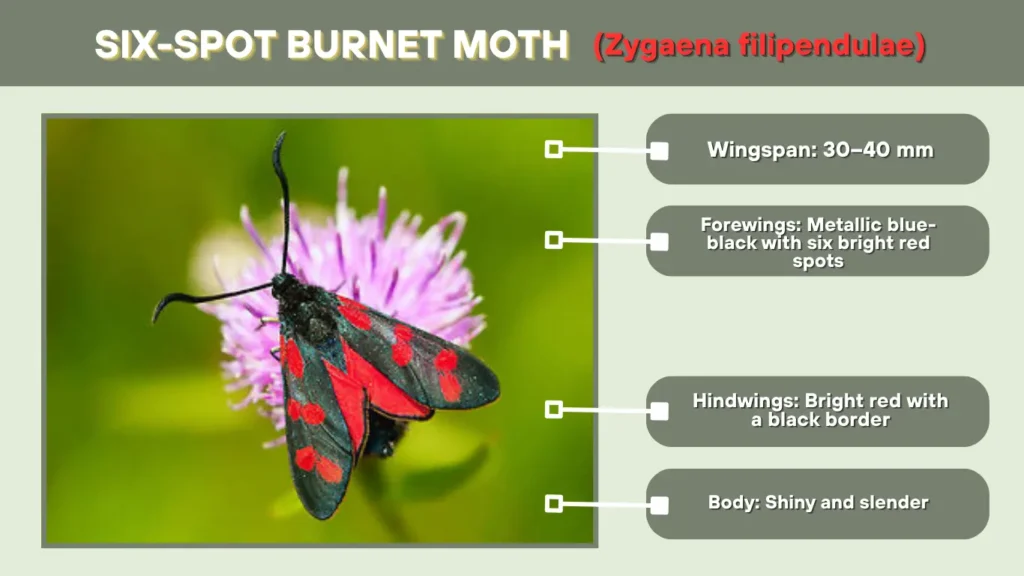
The six-spot burnet moth is a beautiful day-flying species found in grasslands and meadows across Europe. Its red-and-black coloration acts as a warning to predators, as the moth contains toxic compounds.
Identification
- Wingspan: 30–40 mm
- Forewings: Metallic blue-black with six bright red spots
- Hindwings: Bright red with a black border
- Body: Shiny and slender
- Larvae: Greenish-yellow with black spots
Habitat
Prefers wildflower meadows, grassy hillsides, and coastal areas. Often seen on clover or thistle during sunny days.
Lifecycle
Eggs are laid on bird’s-foot trefoil or related plants. Caterpillars feed, then pupate in a papery cocoon attached to grass stems. Adults emerge in mid to late summer.
Behavior
Diurnal and slow-flying, often spotted resting on wildflowers. They rely on their toxic chemistry and warning colors to deter predators.
Diet
Larvae feed on bird’s-foot trefoil. Adults feed on nectar from various wildflowers like knapweed, scabious, and thistle.
29. Cinnabar Moth (Tyria jacobaeae)
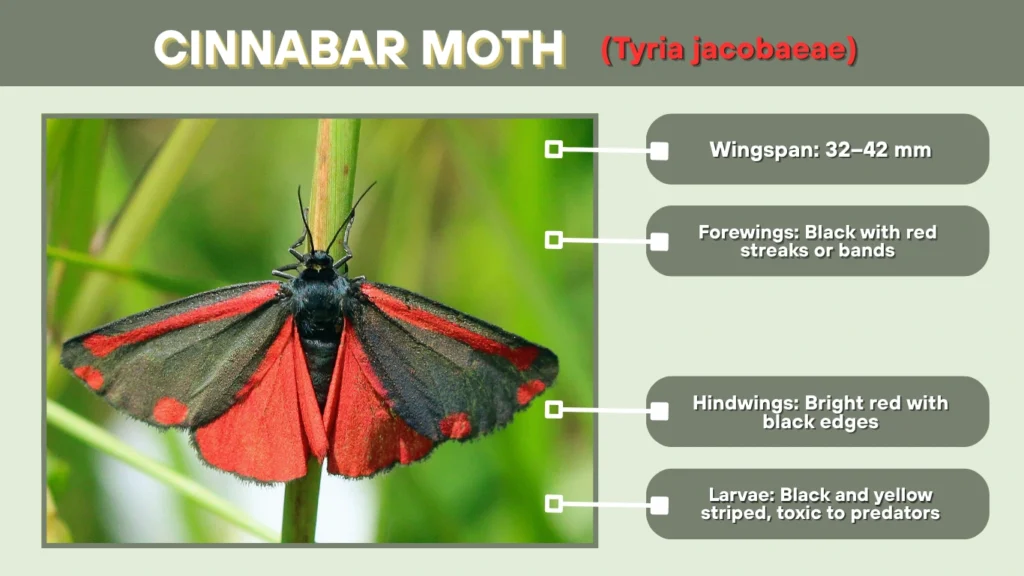
The cinnabar moth is named after the vivid red coloration on its wings. It’s a day-flying species often used in biological control due to its larvae feeding on toxic ragwort plants.
Identification
- Wingspan: 32–42 mm
- Forewings: Black with red streaks or bands
- Hindwings: Bright red with black edges
- Larvae: Black and yellow striped, toxic to predators
Habitat
Found in grasslands, meadows, and disturbed areas across Europe and introduced in parts of New Zealand and North America for ragwort control.
Lifecycle
Eggs are laid on ragwort leaves. Larvae feed in groups and absorb toxins from the plant, making them unpalatable. Pupation occurs in soil over winter. Adults fly in late spring and early summer.
Behavior
Active during the day, especially in sunny, open habitats. Larvae are very visible due to their bold striping and are often seen in large numbers on ragwort.
Diet
Caterpillars feed almost exclusively on ragwort. Adults may sip nectar from flowers but do not rely on feeding.
30. Chinese Oak Silkmoth (Antheraea pernyi)
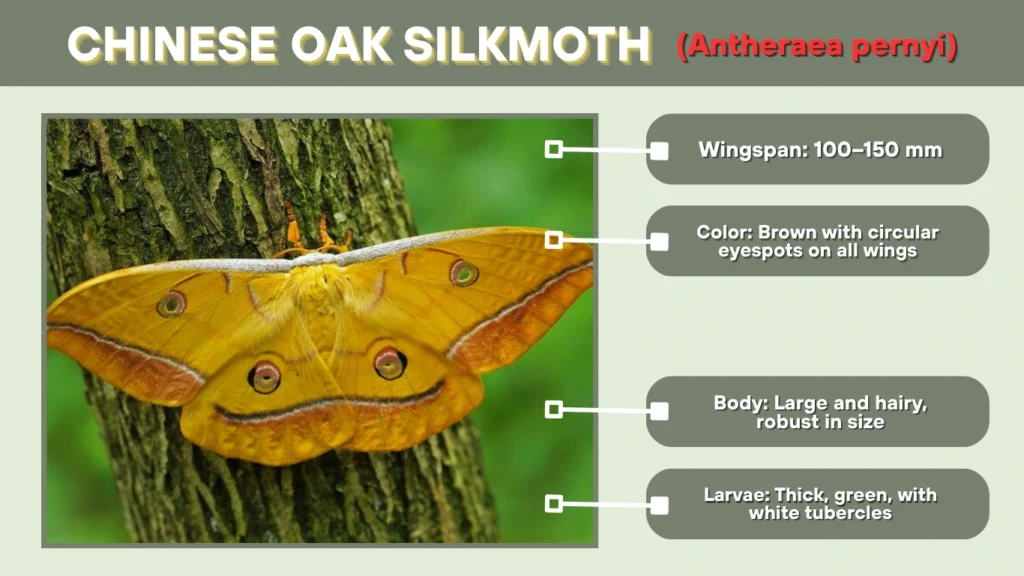
The Chinese oak silkmoth is a large silk-producing moth native to China. It has been cultivated for centuries and is important in commercial silk production in parts of Asia.
Identification
- Wingspan: 100–150 mm
- Color: Brown with circular eyespots on all wings
- Body: Large and hairy, robust in size
- Larvae: Thick, green, with white tubercles
Habitat
Native to China and parts of East Asia, often found near oak trees. In commercial settings, raised in controlled environments for silk harvesting.
Lifecycle
Eggs are laid on oak leaves. Larvae feed and molt multiple times, then spin tough silk cocoons. Adults emerge and mate, completing the cycle in late summer.
Behavior
Mostly nocturnal, though not often seen in the wild due to domestication. In natural settings, adults rest in trees and are active at dusk.
Diet
Caterpillars feed on oak, chestnut, and other deciduous trees. Adults do not feed and live only a few days.

